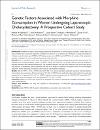The impact of genetic and non-genetic factors on warfarin dose prediction in MENA region: A systematic review
| Author | Bader, Loulia Akram |
| Author | Elewa, Hazem |
| Available date | 2021-03-25T11:33:36Z |
| Publication Date | 2016 |
| Publication Name | PLoS ONE |
| Resource | Scopus |
| Abstract | Background Warfarin is the most commonly used oral anticoagulant for the treatment and prevention of thromboembolic disorders. Pharmacogenomics studies have shown that variants in CYP2C9 and VKORC1 genes are strongly and consistently associated with warfarin dose variability. Although different populations from the Middle East and North Africa (MENA) region may share the same ancestry, it is still unclear how they compare in the genetic and non-genetic factors affecting their warfarin dosing. Objective To explore the prevalence of CYP2C9 and VKORC1 variants in MENA, and the effect of these variants along with other non-genetic factors in predicting warfarin dose. Methods In this systematic review, we included observational cross sectional and cohort studies that enrolled patients on stable warfarin dose and had the genetics and non-genetics factors associated with mean warfarin dose as the primary outcome. We searched PubMed, Medline, Scopus, PharmGKB, PHGKB, Google scholar and reference lists of relevant reviews. Results We identified 17 studies in eight different populations: Iranian, Israeli, Egyptian, Lebanese, Omani, Kuwaiti, Sudanese and Turkish. Most common genetic variant in all populations was the VKORC1 (-1639G>A), with a minor allele frequency ranging from 30% in Egyptians and up to 52% and 56% in Lebanese and Iranian, respectively. Variants in the CYP2C9 were less common, with the highest MAF for CYP2C92 among Iranians (27%). Variants in the VKORC1 and CYP2C9 were the most significant predictors of warfarin dose in all populations. Along with other genetic and non-genetic factors, they explained up to 63% of the dose variability in Omani and Israeli patients. Conclusion Variants of VKORC1 and CYP2C9 are the strongest predictors of warfarin dose variability among the different populations from MENA. Although many of those populations share the same ancestry and are similar in their warfarin dose predictors, a population specific dosing algorithm is needed for the prospective estimation of warfarin dose. |
| Language | en |
| Publisher | Public Library of Science |
| Subject | cytochrome P450 2C9 warfarin CYP2C9 protein, human cytochrome P450 2C9 vitamin K epoxide reductase VKORC1 protein, human warfarin case control study case study cohort analysis cross-sectional study CYP2C9 gene Egyptian gene gene frequency gene sequence genetic variability human Iranian people Israeli Kuwaiti Lebanese observational study Omani prediction prevalence prospective study randomized controlled trial (topic) Review single nucleotide polymorphism Sudanese systematic review Turk (people) VKORC1 gene Africa female genetic variation genetics male metabolism Middle East pharmacogenetic testing Africa, Northern Cytochrome P-450 CYP2C9 Female Genetic Variation Humans Male Middle East Pharmacogenomic Testing Vitamin K Epoxide Reductases Warfarin |
| Type | Article Review |
| Issue Number | 12 |
| Volume Number | 11 |
Files in this item
| Files | Size | Format | View |
|---|---|---|---|
|
There are no files associated with this item. |
|||
This item appears in the following Collection(s)
-
Pharmacy Research [1440 items ]




